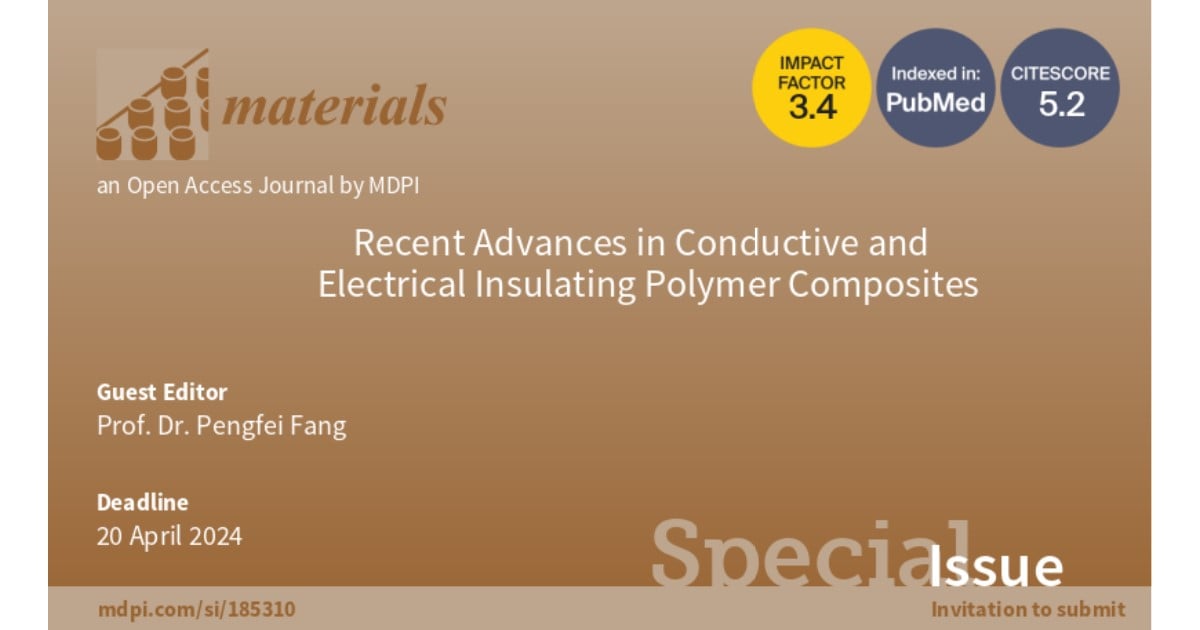Recent Advances in Conductive and Electrical Insulating Polymer Composites
A special issue of Materials (ISSN 1996-1944). This special issue belongs to the section "Advanced Composites".
Deadline for manuscript submissions: 20 October 2024 | Viewed by 4411

Special Issue Editor
Interests: nanomaterials; nanocomposites; composite insulator; piezocatalysis; photocatalysis; polymer composites
Special Issues, Collections and Topics in MDPI journals
Special Issue Information
Dear Colleagues,
Recent advances in conductive and electrical insulating polymer composites have been focused on developing materials with enhanced electrical conductivity and insulation properties. These composites are mainly utilized in various electronic applications, such as printed circuit boards, sensors, and energy storage devices.
One key area of research is the incorporation of fillers into the polymer matrix in order to enhance conductivity. The application of conductive fillers like carbon nanotubes, graphene, and metal nanoparticles has shown promising results regarding improvements in conductivity. Researchers have also explored the use of hybrid composites, in which multiple fillers are combined, in order to further enhance the electrical properties.
To achieve a superior insulation performance, researchers have endeavored to develop novel polymer matrices with high dielectric strengths. One strategy involves modifying the polymer structure to improve alignment and reduce defects, leading to enhanced insulation properties. Another approach involves the incorporation of insulating fillers, such as ceramic nanoparticles or glass fibers, to enhance dielectric strength.
Researchers have also explored various processing techniques in order to optimize the dispersion and interfacial interaction between the polymer matrix and fillers. These techniques include melt blending, solution casting, and in situ polymerization. These methods aim to achieve a uniform distribution of fillers and promote strong adhesion between the matrix and fillers, which directly impact the electrical properties of the composites.
Overall, recent advances in conductive and electrical insulating polymer composites have showcased promising developments in both conductivity and insulation performance. By tailoring the composition, structure, and processing methods, researchers are working towards developing composites with superior electrical properties for a wide range of electronic applications.
We look forward to receiving your contributions to this Special Issue!
Prof. Dr. Pengfei Fang
Guest Editor
Manuscript Submission Information
Manuscripts should be submitted online at www.mdpi.com by registering and logging in to this website. Once you are registered, click here to go to the submission form. Manuscripts can be submitted until the deadline. All submissions that pass pre-check are peer-reviewed. Accepted papers will be published continuously in the journal (as soon as accepted) and will be listed together on the special issue website. Research articles, review articles as well as short communications are invited. For planned papers, a title and short abstract (about 100 words) can be sent to the Editorial Office for announcement on this website.
Submitted manuscripts should not have been published previously, nor be under consideration for publication elsewhere (except conference proceedings papers). All manuscripts are thoroughly refereed through a single-blind peer-review process. A guide for authors and other relevant information for submission of manuscripts is available on the Instructions for Authors page. Materials is an international peer-reviewed open access semimonthly journal published by MDPI.
Please visit the Instructions for Authors page before submitting a manuscript. The Article Processing Charge (APC) for publication in this open access journal is 2600 CHF (Swiss Francs). Submitted papers should be well formatted and use good English. Authors may use MDPI's English editing service prior to publication or during author revisions.
Keywords
- silicone rubber
- composite insulating materials
- insulating coatings
- fiber-reinforced insulating materials
- conductive composites






